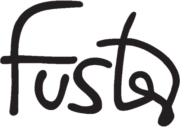To transform a whole neighborhood into a work of art? That crazy Fuster did it.
By Jean-Hervé Deiller (AFP) – published by Associated France Press (AFP)
JAIMANITAS, Cuba — If it is true that you have to be a bit nuts in order to transform a fishermen’s neighborhood into a work of art, then there’s an opportunity of a future for Cuban artist Jose Fuster. He’s hooked to the craziness of his ambitions, and the small town where he lives – Jaimanitas – thanks him wholeheartedly for it. A short distance from Fidel Castro’s residence, Fuster undertook fifteen years ago an endless task: to return to this humble village at the seaside “a bit of the life that it has endowed me with,” by disseminating his colorful ceramics.

After thirty years of paintings, designs and etchings, he decided to make his own dreams come true. “I had to grow,” explains this short 64-years-old man who is incapable of hiding his mischievousness behind his shortsighted glasses and his meager beard. The result has brought joy to his neighbors by bringing colors back to this lost neighborhood: dozens of rebuilt facades, a vast tribute to Catalonian architect Antonio Gaudi, the influences of Romanian sculptor Constantin Brancusi, a giant chessboard, a monument to glorify the “Five Heroes” – agents imprisoned in the US, accused of being spies and whose liberation is being demanded by Cuba since 1998.
“After so many years of painting and design, so many years of exhibitions and trips, I needed to go on to another stage.” By the might of his brush, Fuster earned the nickname of “Naif Picasso,” and the price of his works frequently exceeds € 10 000 in Western galleries.
“Picasso is my spiritual father and Gaudi my favorite uncle, but my brother is Sosabravo”, he sumarizes with respect to the great Cuban artist Alfredo Sosabravo, who was his teacher at the Havana Art School, where he studied between 1963 and 1965.
For José Antonio Rodríguez Fuster, it all began with the 1959 Cuban Revolution. Barely 14 years old at the time, he took part in the literacy campaign launched by Fidel Castro and, in order to teach the illiterate, he climbed the Sierra Maestra mountains, at the heart of what had been the bastion of the barbudos (bearded guerrilla fighters).
“It was there that I experienced my call as an artist. It was there that I discovered a world that always follows me around, everywhere I go: the palm tree, the peasant with his hat, the horse and the rooster,” to which a “Tower of the Rooster” pays tribute in the garden of his house at Jaimanitas, one of his first monumental works.
And this heir of the tradition of the great Cuban ceramists –Amelia Pelaez, Wifredo Lam, Rene Portocarrero- remained faithful to the Revolution, in spite of his many trips and exhibitions that have honored him abroad worldwide, from the United States to most European countries, passing through all of South America.
“The government never gave me a penny for the work I have undertaken. This is something normal, because it has to deal with education, health services, it cannot afford the luxury of spending funds on people like me. But it has always supported my projects,” he says, hinting about the distrust that marked his initial steps into “urban ceramics.”
“I am not a communist, because communism does not exist, it never did; but I am, of course, a revolutionary,” he underlines. And he concludes: “To be a revolutionary nowadays means to be aware of all the problems that threaten the world, because we have to defend this planet”.


